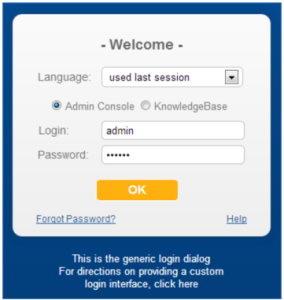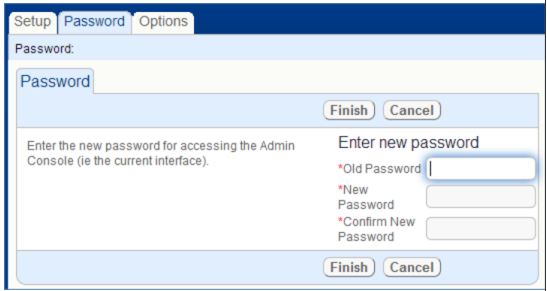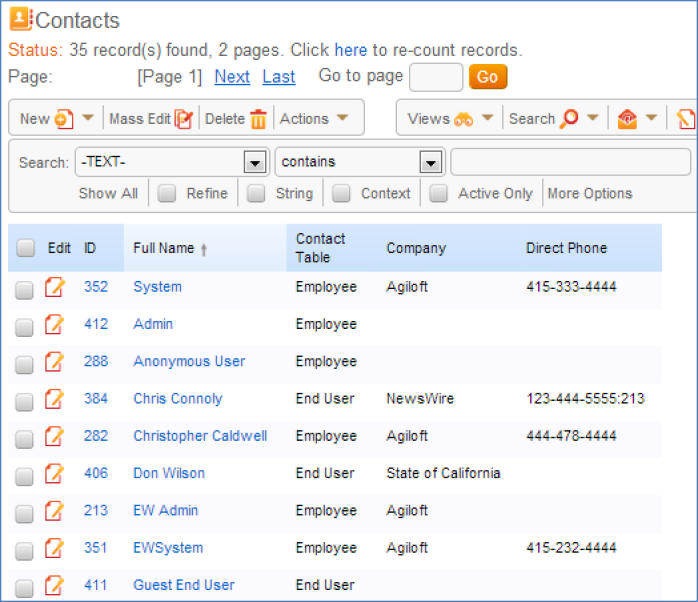To The following articles provide guidelines and general recommendations to help ensure the security of
| Companyname |
|---|
Use complex passwords
Passwords that are resistant to attack should be at least 8 characters in length, contain a mixture of upper and lower-case characters, contain one or more numbers or other non-alphabetic characters, and not be derived in any obvious way from the username. All staff accounts should be secured with such passwords, especially those in the Admin group. If it is desired to give end-user accounts simple passwords for user convenience, then these accounts should be severely restricted in what they may do (for example only filling out a single form). End-user accounts with the ability to modify existing records or view sensitive data should also be given attack-resistant passwords.
Change the password
Change the password of the Admin Console and default KnowledgeBase users. These default passwords are well-known, and are an extremely easy method of attack.
To change the Admin Console password, do the following:
- Log in to the Admin Console:
- Select the Password tab:
- Enter the existing and new passwords and click Finish.
Sample Users
Each knowledgebase you create is automatically populated with a number of sample users:
The users: Anonymous, faquser , register are essential to certain functionalities. Users like admin and ewsystem should have their passwords changed to be more secure. Remaining users should be deleted, as they are probably not relevant to your organization.
The ewsystem user is used by
| Companyname |
|---|
To change the password:
- Log into a knowledgebase and select Contacts > View Contacts, as shown above.
- Click the Edit icon to edit the user's information, and select the Account Info tab:
- Enter the new password in the fields and click Finish.
Assign users to
| Companyname |
|---|
Users should not be assigned privileges they do not need or do not have the skills to use safely. For example, a user with the ability to delete all records in a table in one operation can do considerable damage accidentally if they are not familiar enough with
| Companyname |
|---|
Use SSL
Use SSL (via HTTPS) to secure Web browser connections to the
| Companyname |
|---|
| Companyname |
|---|
To connect to your Web server using SSL, you will need to configure it, as it is not the default configuration. You will need to purchase or generate a server certificate that authenticates your server to the clients. This configuration differs depending on the host operating system type and release, and the Web server software in use. The following resources may help:
Securing Your Apache 2 Server with SSL
Van's Apache SSL/TLS mini-HOWTO
Even if you must allow access to some accounts through standard HTTP, ensure that HTTPS is used to access more sensitive accounts such as those in the admin group of knowledgebases and the Admin Console.
Restrict login access to the
| Companyname |
|---|
A root user on Unix/Linux or a user in the Administrators group on Windows can circumvent
| Companyname |
|---|
| Companyname |
|---|
Restrict services accessible on the
| Companyname |
|---|
Treat the
| Companyname |
|---|
| Companyname |
|---|
| Companyname |
|---|
The default services installed with most recent Linux distributions are generally minimal. You should use the nmap tool to verify which ports are exposed on your server. For example:
| Code Block | ||
|---|---|---|
| ||
linux# nmap -sS wizard.example.com
Starting Nmap 4.00 ( http://www.insecure.org/nmap/ ) at 2006-12-14 18:12 PST
Interesting ports on wizard.example.com (10.0.0.1):
(The 1667 ports scanned but not shown below are in state: filtered)
PORT STATE SERVICE
22/tcp open ssh
80/tcp open http
113/tcp closed auth
443/tcp open https
8080/tcp open http-proxy
MAC Address: 00:E0:81:00:00:12 (Tyan Computer)
Nmap finished: 1 IP address (1 host up) scanned in 64.320 seconds
linux# |
. When configuring your system, make sure you read and follow the recommendations in these articles to guard against potential security vulnerabilities.
- General Security Guidelines: Provides a set of best practices for ensuring your system is secure.
- Password Management: Provides recommendations for strong passwords, characteristics of the Password Field wizard, and instructions for changing passwords.
- Hotlinks: Describes how to use hotlinks for user authentication and how to encrypt hotlinks. For general information on hotlinks, see Hyperlinks.
...
| Companyname |
|---|
...
| Companyname |
|---|
...
| Companyname |
|---|
...
| Hide If | ||||||||||||||||||
|---|---|---|---|---|---|---|---|---|---|---|---|---|---|---|---|---|---|---|
| ||||||||||||||||||
Related articles
|
...
|




